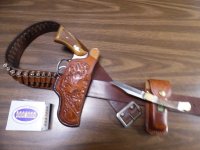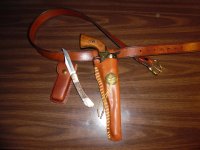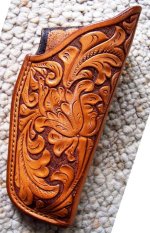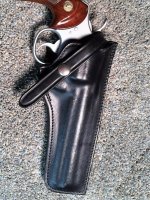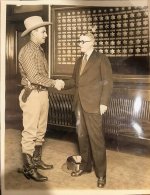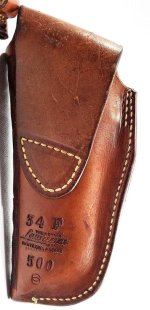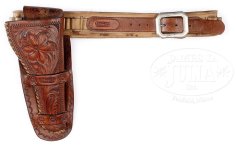rednichols
Member
The Threepersons Style holster has been ill-defined since 1931 when it first appeared in a Myres catalogue.
S.D. Myres, 1931: “No. 614 Tom Threepersons Style, full hand carved, trigger set high for easy draw” . . . No. 640 Tom Threepersons Style holster full hand carved, heavy seamed filler, trigger set high for quick draw”.
H.H. Heiser, 1939: “No. 457 . . . belt loop on back, there is a welt down the side but does not extend clear across bottom, welt permits a snug fit. A small hole is left in bottom to permit any dirt to sift out. Gun sets high exposing trigger guard and trigger. This holster was designed for the FBI of Washington DC who require holster for fast draw. Made for revolvers only”.
Chic Gaylord, 1960: “. . . Tom Threepersons designed a fine holster. He took the old Skintite holster, raised it higher on the belt, and canted it butt forward to a marked degree. This holster, as made by the late Tio Sam Myres, was perhaps the best holster of that era. With minor modification it is the issue holster of the FBI today.”
Sandra Myres, 1961: “Tom Threepersons, a former Canadian Mountie and deputy Marshall in El Paso, designed a holster which is still popular today. Adaptable to both gun belt and shoulder rigging, the Threepersons was designed to allow the trigger of the weapon to set high for easy and fast drawing”.
Charlie Askins 1954: “At any rate Threepersons developed the most famous holster in the Southwest today . . . This harness is simplicity itself. It is made only for revolvers and consists of a holster-well which accepts only the barrel and cylinder of the gun. The secret of the rig is that the weight of the weapon rests on the trigger guard, which strongly bears on the rear seam of the holster . . . The holster-well itself does not touch the barrel, the hammer is free and stands well above the holster. The stock of the gun is likewise far above the leather . . . Beyond this the angel at which the harness swings is another highly important feature. The holster does not hang straight down the leg but is angled to the rear most noticeably.
BATFE, 2009: “Threepersons designed a holster that exposed all of the trigger guard, hammer and grip frame of a Colt Single Action Army . . . The holster rode high and tight on the belt with a rearward cant and the grip frame, hammer and trigger placed above the belt where nothing could interfere with quick gun handling.”.
Bob Arganbright, 1986: “The Threepersons holster . . . trimmed the holster of al unnecessary leather, setting the holster high on the belt with hammer and trigger guard clear of leather and above the belt. The gun butt was tipped slightly forward for a faster draw (the FBI cant).”
Roger Combs, 1984: “The top of the holster was cut low to expose much more of the gun butt than was heretofore popular. The trigger and trigger guard were completely exposed.”
John Bianchi, 1978: “The design was spare, minimising the amount of leather needed to support the gun. The holster top as cut low to expose the gun for quick-draw grasping and early muzzle clearance. The trigger guard was completely exposed . . ..”
Packing Iron, 1993: Neither Tom Threepersons nor his holster are mentioned.
John Bianchi American Legend, 2010: Neither Tom Threepersons nor his holster are mentioned.
Bill Jordan, 1965: Neither Tom Threepersons nor his holster are mentioned (though the style is illustrated).
I'll propose to you all, that if one used any or all of the above as a specification to a factory in China, you would not receive samples that looked or worked anything like a Threepersons holster .
.
We can explore what a Threepersons holster REALLY is, by examining the several iterations of it that have achieved some fame:
 Myres since circa 1930
Myres since circa 1930
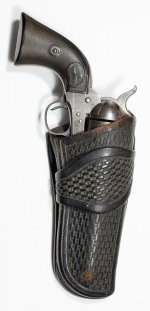 Brill since circa 1910
Brill since circa 1910
 Heiser since circa 1940
Heiser since circa 1940
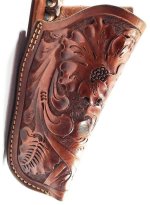 Lawrence since circa 1950
Lawrence since circa 1950
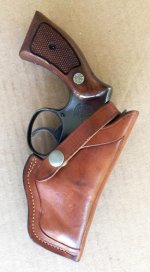 Wolfram since circa 1960
Wolfram since circa 1960
S.D. Myres, 1931: “No. 614 Tom Threepersons Style, full hand carved, trigger set high for easy draw” . . . No. 640 Tom Threepersons Style holster full hand carved, heavy seamed filler, trigger set high for quick draw”.
H.H. Heiser, 1939: “No. 457 . . . belt loop on back, there is a welt down the side but does not extend clear across bottom, welt permits a snug fit. A small hole is left in bottom to permit any dirt to sift out. Gun sets high exposing trigger guard and trigger. This holster was designed for the FBI of Washington DC who require holster for fast draw. Made for revolvers only”.
Chic Gaylord, 1960: “. . . Tom Threepersons designed a fine holster. He took the old Skintite holster, raised it higher on the belt, and canted it butt forward to a marked degree. This holster, as made by the late Tio Sam Myres, was perhaps the best holster of that era. With minor modification it is the issue holster of the FBI today.”
Sandra Myres, 1961: “Tom Threepersons, a former Canadian Mountie and deputy Marshall in El Paso, designed a holster which is still popular today. Adaptable to both gun belt and shoulder rigging, the Threepersons was designed to allow the trigger of the weapon to set high for easy and fast drawing”.
Charlie Askins 1954: “At any rate Threepersons developed the most famous holster in the Southwest today . . . This harness is simplicity itself. It is made only for revolvers and consists of a holster-well which accepts only the barrel and cylinder of the gun. The secret of the rig is that the weight of the weapon rests on the trigger guard, which strongly bears on the rear seam of the holster . . . The holster-well itself does not touch the barrel, the hammer is free and stands well above the holster. The stock of the gun is likewise far above the leather . . . Beyond this the angel at which the harness swings is another highly important feature. The holster does not hang straight down the leg but is angled to the rear most noticeably.
BATFE, 2009: “Threepersons designed a holster that exposed all of the trigger guard, hammer and grip frame of a Colt Single Action Army . . . The holster rode high and tight on the belt with a rearward cant and the grip frame, hammer and trigger placed above the belt where nothing could interfere with quick gun handling.”.
Bob Arganbright, 1986: “The Threepersons holster . . . trimmed the holster of al unnecessary leather, setting the holster high on the belt with hammer and trigger guard clear of leather and above the belt. The gun butt was tipped slightly forward for a faster draw (the FBI cant).”
Roger Combs, 1984: “The top of the holster was cut low to expose much more of the gun butt than was heretofore popular. The trigger and trigger guard were completely exposed.”
John Bianchi, 1978: “The design was spare, minimising the amount of leather needed to support the gun. The holster top as cut low to expose the gun for quick-draw grasping and early muzzle clearance. The trigger guard was completely exposed . . ..”
Packing Iron, 1993: Neither Tom Threepersons nor his holster are mentioned.
John Bianchi American Legend, 2010: Neither Tom Threepersons nor his holster are mentioned.
Bill Jordan, 1965: Neither Tom Threepersons nor his holster are mentioned (though the style is illustrated).
I'll propose to you all, that if one used any or all of the above as a specification to a factory in China, you would not receive samples that looked or worked anything like a Threepersons holster
We can explore what a Threepersons holster REALLY is, by examining the several iterations of it that have achieved some fame:
 Myres since circa 1930
Myres since circa 1930 Brill since circa 1910
Brill since circa 1910 Heiser since circa 1940
Heiser since circa 1940 Lawrence since circa 1950
Lawrence since circa 1950 Wolfram since circa 1960
Wolfram since circa 1960
